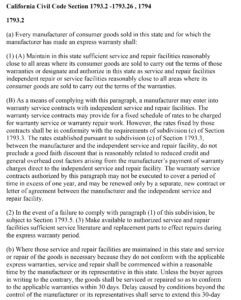California Lemon Law
What’s covered under the California Lemon Law
The California Lemon Law coverage only applies to NEW vehicles used primarily designed personal, family, or household purposes. Or a NEW vehicle under 10,000 pounds that is bought or used primarily for business purposes by a person, including a partnership, limited liability company, corporation, association, or any other legal entity, to which not more than five motor vehicles are registered in this state.
The Lemon Law provisions may be invoked in the event you have had 4 unsuccessful repair attempts for the same defect, the vehicle is out of service for a cumulative total of 30 days, or you have had 2 unsuccessful repair attempts for a defect likely to cause death or serious injury within 18 months or 18,000 miles of purchase or a “reasonable” number of repair attempts during the entire express warranty period.
What’s the definition of a “defect” or “non-conforming condition” under the California Lemon Law?
Under California law, a “non-conformity” a problem which substantially impairs the use, value, or safety of the new motor vehicle to the buyer or lessee.
The non-conformity must not be the result of alteration, abuse or neglect by the owner or their agents.
Who can invoke the California Lemon Law
Only the purchaser can invoke the terms of the California Lemon Law.
How to invoke the California Lemon Law
If the manufacturer has an established an informal dispute settlement procedure that’s documented in your owner’s manual or on its website and that settlement procedure meets the terms of federal rules and regulations of 16 C.F.R. 703, you must use that settlement procedure first before invoking the terms of the California Lemon Law.
The settlement procedure must process your claim within 40-days and the arbitration decision must be rendered within 40-days after filing. If you accept the arbitrator’s decision, the manufacturer must perform according the decision within 30-days.
If you’re participated in the manufacturer’s informal dispute settlement process and your problem is still not resolved and you intend to invoke the terms of the California Lemon Law you must notify the car or truck maker by following the procedures shown in the manufacturer’s warranty terms.
What the California Lemon Law allows if the manufacturer can’t fix the defect
If you’ve followed the procedure and given the manufacturer a final opportunity to fix the defect and they are unable to do so, the manufacture shall, at your option and within 40-days, allow you to return the vehicle for
1) Replace the vehicle with a vehicle acceptable to you or
2) Repurchase the vehicle using the full purchase price minus a reasonable allowance for the mileage accumulated since purchase and any physical damage.
The manufacturer must also reimburse you for necessary towing and rental costs actually incurred as a direct result of the nonconformity.
Avoid these common mistakes that can ruin your chances of recovering under the terms of the California Lemon Law
1) Not keeping the written service records. This is your evidence. The records should include the vehicle VIN, date of service, mileage and description of the problem. Even if the technician can’t duplicate the condition, you must keep the paperwork.
2) Allowing the service department to examine the vehicle without writing up an actual service report. Never allow the service writer or technician to check or test drive the vehicle without a written service report. In other words, never leave the dealer without documentation that you brought the vehicle in for repair.
3) Not being clear with the service writer about the actual problem. In you hear a noise, describe the noise. Do NOT try to diagnose the problem yourself or try to identify the source of the noise. That’s THEIR job. If you say the noise is coming from the tires or transmission and the technician determines those components aren’t the source of the noise and they can’t hear the noise, you’ve wasted one of your three opportunities. Be general. If you hear a clunk, just say you hear a clunk. Before you sign the service order, make sure your complaint accurately describes the condition you want addressed.
4) Not checking the service order before leaving the dealer. Make sure no changes have been made to the work order before you leave the dealer. The order must include the description of the problem.
5) Waiting too long to get the problem addressed. Remember, the first report of the problem must occur within the first year of ownership and within the first 12,000 miles.
6) Failing to provide all the necessary information in your certified letter to the manufacturer. Include all copies of your paperwork in your notice. Don’t hold anything back.
7) Giving the dealer more than three chances. The dealer is supposed to follow set procedures when they can’t fix a problem. Dealers don’t like to do that, so they try to convince you to give them more chances. Don’t fall for that. After the third chance, initiate the informal dispute resolution process and then follow through with invoking the formal notification.
8) Not allowing the manufacturer a final chance. Yeah, you have to do this. If you don’t, kiss your California Lemon Law protection goodbye.
Download the California Lemon Law Statute
Posted on by Rick Muscoplat


